The GHG Emissions Assessment of Online Car-Hailing Development under the Intervention of Evaluation Policies in China
Abstract
:1. Introduction
2. Module and Scenario Design
| Parameter (Unit) | Symbol | Value | Explanation and References |
|---|---|---|---|
| Selection probability (%) | P | / | Retrieved from multivariate logit (mlogit) selection model |
| Multivariate logit regression | V | / | From our calculation |
| Sales of vehicles (unit) | Sales | / | Reference [36] |
| Stock of vehicles (unit) | stock | / | Retrieved from CEIC database and different PRMOCH requirements |
| Private vehicle survival rate (%) | Sr | / | The coefficients were derived from research by Han et al. (2011) |
| Well-to-tank stage (L) | WTT | / | Reference [37] |
| Tank-to-wheel stage (L) | TTW | / | Reference [37] |
| Replacement coefficient of online car-hailing | Pre | 0.06 | Retrieved from the research report of China International Capital Corporation Limited (CICC) |
| Average annual mileage (km) | VKT | 18,000 | Reference (China’s Technical Guidelines for the Preparation of Air Pollutant Emission Inventory for Road Vehicles) |
| GHG emission reduction | ER | / | From our calculation |
| GHG emissions of online car-hailing | EC | / | From our calculation |
2.1. Restricted Index Selection Module
2.2. Vehicle Inventory Calculation Module
2.3. Carbon Emission Impact Module
2.4. Equivalent Computing
3. Data
3.1. Explanatory Variables
3.2. Control Variables
3.2.1. Urban Registered Unemployment
3.2.2. Number of Taxis
3.2.3. Gasoline Price
3.2.4. Numbers of Charging Piles
3.3. Predetermination Factors
3.3.1. Automobile Stock
3.3.2. Market Supply of Drivers
3.3.3. EV Sales
3.3.4. GHG Emissions
4. Results
4.1. Calculating the Selection Probability of the Displacement Type of Vehicle
4.2. Market Penetration and Changes under Different Policy Implementations
4.2.1. Market Penetration of Online Car-Hailing
4.2.2. Changes in Market Penetration under Different Policies
4.3. GHG Emissions from Online Car-Hailing
4.4. Emissions Reduction for Online Car-Hailing
4.5. Assessment of the Reduction Effect on Other Pollutant Gases
4.6. Assessment of the COVID-19 Epidemic Impact
5. Discussions
6. Conclusions
Author Contributions
Funding
Data Availability Statement
Acknowledgments
Conflicts of Interest
Appendix A
| Variable | Unit | N | Mean | Sd | Min | Max |
|---|---|---|---|---|---|---|
| Wheelbase | mm | 249 | 2549.98 | 173.81 | 2350 | 3000 |
| Wheelbase of hybrid car | 249 | 2418.47 | 61.24 | 2400 | 2700 | |
| Wheelbase for new energy vehicle EV cruising range | 249 | 2310.4 | 305.63 | 2000 | 2700 | |
| km | 249 | 147.19 | 76.19 | 80 | 260 | |
| Vehicle insurance maximum compensation | Ten thousand (CNY) | 249 | 26.99 | 32.91 | 10 | 100 |
| Vehicle price | 249 | 8.06 | 2.58 | 6 | 16 | |
| Term of transport license | Year | 249 | 6.36 | 2.29 | 3 | 8 |
| Age of vehicle | 249 | 2.67 | 1.09 | 1 | 6 | |
| Term of driving license Driving qualification certificate revocation record | 249 | 0.81 | 1.61 | 1 | 8 | |
| 249 | 0.69 | 1.12 | 1 | 3 | ||
| Emissions | L | 249 | 1.25 | 0.32 | 1 | 2 |
| Criminal record | NA(0) Yes(1) regulations | 249 | 1 | 0 | 1 | 1 |
| Dangerous driving record | 249 | 0.98 | 0.15 | 0 | 1 | |
| Drug abuse record | 249 | 0.98 | 0.15 | 0 | 1 | |
| Drunk record | 249 | 0.98 | 0.15 | 0 | 1 | |
| Violence | 249 | 0.97 | 0.17 | 0 | 1 | |
| Seating capacity of the vehicle | 249 | 0.97 | 0.17 | 0 | 1 | |
| Illegal behavior | 249 | 0.96 | 0.19 | 0 | 1 | |
| Car registration | 249 | 0.94 | 0.23 | 0 | 1 | |
| Driving experience | 249 | 0.94 | 0.25 | 0 | 1 | |
| Whether they passed the integrity assessment | 249 | 0.93 | 0.25 | 0 | 1 | |
| Vehicle driving period | 249 | 0.89 | 0.31 | 0 | 1 | |
| Driver registration | 249 | 0.82 | 0.38 | 0 | 1 | |
| Punishment regulation | 249 | 0.75 | 0.43 | 0 | 1 | |
| Driver age requirement | 249 | 0.69 | 0.46 | 0 | 1 | |
| Driver health requirement | 249 | 0.53 | 0.5 | 0 | 1 | |
| Traffic crime record | 249 | 0.33 | 0.47 | 0 | 1 | |
| Passenger requirements | 249 | 0.31 | 0.46 | 0 | 1 | |
| Requirements for establishing a bad record list system | 249 | 0.18 | 0.38 | 0 | 1 | |
| Body length requirements | 249 | 0.1 | 0.3 | 0 | 1 | |
| Driver education requirements | 249 | 0.08 | 0.28 | 0 | 1 |
Appendix B
| Model 1 | Model 2 | Model 3 | Model 4 | Model 5 | ||||||
|---|---|---|---|---|---|---|---|---|---|---|
| (1) | (2) | (1) | (2) | (1) | (2) | (1) | (2) | (1) | (2) | |
| driving_licence_term | −0.0414 | 0.375 ** | −0.0414 | 0.375 ** | −0.0455 | 0.399 ** | −0.0474 | 0.398 ** | −0.11 | 0.27 |
| (−0.33) | (−2.74) | (−0.33) | (−2.74) | (−0.37) | (−2.97) | (−0.38) | (−2.89) | (−0.87) | (−1.77) | |
| vehicle_prices | −1.257 *** | −0.126 | −1.257 *** | −0.126 | −1.237 *** | −0.0822 | −1.221 *** | −0.0959 | −1.371 *** | −0.02 |
| (−4.83) | (−0.48) | (−4.83) | (−0.48) | (−4.81) | (−0.31) | (−4.78) | (−0.36) | (−4.81) | (−0.07) | |
| number_of_seats | 1.824 ** | 2.615 ** | 1.824 ** | 2.615 ** | 1.846 ** | 2.384 ** | 1.876 ** | 2.561 ** | 1.477 * | 1.418 |
| (−2.63) | (−3.25) | (−2.63) | (−3.25) | (−2.66) | (−3.05) | (−2.74) | (−3.17) | (−2.04) | (−1.57) | |
| health | 1.088 ** | 1.218 * | 1.088 ** | 1.218 * | 1.075 ** | 1.319 * | 1.133 ** | 0.995 | 1.182 ** | 1.029 |
| (−2.94) | (−2.09) | (−2.94) | (−2.09) | (−2.92) | (−2.28) | (−3.11) | (−1.75) | (−3.1) | (−1.69) | |
| endurance_mileage | 0.0332 | 0.0614 | 0.0332 | 0.0614 | 0.0315 | 0.0463 | ||||
| (−0.42) | (−0.53) | (−0.42) | (−0.53) | (−0.4) | (−0.41) | |||||
| if_traffic_ Violation_record | −0.0543 | 0.7 | −0.0543 | 0.7 | −0.0307 | 0.642 | ||||
| (−0.14) | (−1.27) | (−0.14) | (−1.27) | (−0.08) | (−1.16) | |||||
| if_criminal_record | 0.934 | −1.926 | 0.934 | −1.926 | 0.832 | −1.978 | ||||
| (−0.89) | (−1.51) | (−0.89) | (−1.51) | (−0.79) | (−1.56) | |||||
| driving_time_limit | 0.265 | 0.198 | 0.363 | 0.785 | ||||||
| (−0.41) | (−0.23) | (−0.55) | (−0.82) | |||||||
| bodywork_length | −0.0608 | 1.781 * | 0.149 | 1.720 * | ||||||
| (−0.10) | (−2.44) | (−0.24) | (−2.24) | |||||||
| vehicle_wheelbase | 0.42 | 1.027 ** | ||||||||
| (−1.18) | (−2.7) | |||||||||
| transport_license_term | 0.0322 | −0.191 | ||||||||
| (−0.4) | (−1.41) | |||||||||
| BC wheelbase | 0.174 ** | 0.13 | ||||||||
| (−2.76) | (−1.33) | |||||||||
| cityye | −0.858 | −0.0205 | −0.858 | −0.0205 | −0.815 | −0.136 | −0.76 | 0.266 | −1.144 | 0.294 |
| (−1.18) | (−0.02) | (−1.18) | (−0.02) | (−1.11) | (−0.15) | (−1.04) | (−0.3) | (−1.52) | (−0.31) | |
| fuel95 | 10.55 *** | 3.27 | 10.55 *** | 3.27 | 10.38 *** | 3.574 | 10.27 *** | 1.304 | 10.50 *** | 2.041 |
| (−3.59) | (−0.78) | (−3.59) | (−0.78) | (−3.53) | (−0.88) | (−3.53) | (−0.3) | (−3.4) | (−0.43) | |
| fuel92 | −8.135 * | −4.414 | −8.135 * | −4.414 | −7.866 * | −5.106 | −8.259 * | −2.349 | −8.530 * | −2.449 |
| (−2.46) | (−0.92) | (−2.46) | (−0.92) | (−2.36) | (−1.09) | (−2.47) | (−0.48) | (−2.46) | (−0.45) | |
| Unemployed _persons | 0.0000492 ** | 0.00000356 | 0.0000492 ** | 0.00000356 | 0.0000487 ** | 0.0000035 | 0.0000516 ** | −0.00000579 | 0.0000557 ** | −0.00000627 |
| (−2.64) | (−0.22) | (−2.64) | (−0.22) | (−2.59) | (−0.22) | (−2.68) | (−0.35) | (−2.71) | (−0.36) | |
| numbe_of_taxis | −0.00014 | 0.000153 | −0.00014 | 0.000153 | −0.00014 | 0.000161 | −0.000146 | 0.000136 | −0.000174 | 0.000144 |
| (−1.21) | (−1.27) | (−1.21) | (−1.27) | (−1.20) | (−1.37) | (−1.25) | (−1.17) | (−1.40) | (−1.14) | |
| cdz | −0.00199 | −0.000621 | −0.00199 | −0.000621 | −0.00201 | −0.000814 | −0.00222 | 0.000558 | −0.00291 | −0.00000262 |
| (−0.86) | (−0.25) | (−0.86) | (−0.25) | (−0.87) | (−0.33) | (−0.93) | (−0.22) | (−1.12) | (−0.00) | |
| _cons | −22.11 * | 0.631 | −22.11 * | 0.631 | −22.81 * | 3.112 | −19.11 | −1.602 | −18.73 | −4.067 |
| (−2.06) | (−0.04) | (−2.06) | (−0.04) | (−2.13) | (−0.19) | (−1.89) | (−0.10) | (−1.83) | (−0.22) | |
| 234 | 234 | 234 | 234 | 234 | ||||||
References
- Zhou, K.; Li, Y. Carbon finance and carbon market in China: Progress and challenges. J. Clean. Prod. 2019, 214, 536–549. [Google Scholar] [CrossRef]
- Li, F.; Cai, B.; Ye, Z.; Wang, Z.; Zhang, W.; Zhou, P.; Chen, J. Changing patterns and determinants of transportation carbon emissions in Chinese cities. Energy 2019, 174, 562–575. [Google Scholar] [CrossRef]
- Kechagias, E.P.; Gayialis, S.P.; Konstantakopoulos, G.D.; Papadopoulos, G.A. Traffic flow forecasting for city logistics: A literature review and evaluation. Int. J. Decis. 2019, 4, 159–176. [Google Scholar] [CrossRef]
- Zhang, L.; Long, R.; Chen, H.; Geng, J. A review of China’s road traffic carbon emissions. J. Clean. Prod. 2019, 207, 569–581. [Google Scholar] [CrossRef]
- Kechagias, E.P.; Miloulis, D.M.; Chatzistelios, G.; Gayialis, S.P.; Papadopoulos, G.A. Applying a system dynamics approach for the pharmaceutical industry: Simulation and optimization of the quality control process. WSEAS Trans. Environ. Dev. 2021, 17, 983–996. [Google Scholar] [CrossRef]
- Brohi, S.N.; Pillai, T.R.; Asirvatham, D.; Ludlow, D.; Bushell, J. Towards smart cities development: A study of public transport system and traffic-related air pollutants in Malaysia. Iop Conf. Ser. Earth Environ. Sci. IOP Publ. 2018, 167, 012015. [Google Scholar] [CrossRef]
- Konstantakopoulos, G.D.; Gayialis, S.P.; Kechagias, E.P.; Papadopoulos, G.A.; Tatsiopoulos, I.P. An algorithmic approach for sustainable and collaborative logistics: A case study in Greece. Int. J. Inf. Manag. Data Insights 2021, 1, 100010. [Google Scholar] [CrossRef]
- Jia, S.; Yan, G.; Shen, A. Traffic and emissions impact of the combination scenarios of air pollution charging fee and subsidy. J. Clean. Prod. 2018, 197, 678–689. [Google Scholar] [CrossRef]
- Zhu, G.; Li, H.; Li, Z. Enhancing the development of sharing economy to mitigate the carbon emission: A case study of online ride-hailing development in China. Nat. Hazards 2018, 91, 611–633. [Google Scholar] [CrossRef]
- Hazée, S.; Vaerenbergh, Y.V.; Delcourt, C.; Kabadayi, S. Service delivery system design for risk management in sharing-based product service systems: A customer-oriented approach. Int. J. Oper. Prod. Manag. 2020, 40, 459–479. [Google Scholar] [CrossRef]
- Li, D.; Huang, Y.; Sun, H.; Zhi, B. Achieving sustainability in sharing-based product service system: A contingency perspective. J. Clean. Prod. 2022, 332, 129997. [Google Scholar] [CrossRef]
- Akbar, P.; Hoffmann, S. Creating value in product service systems through sharing. J. Bus. Res. 2020, 121, 495–505. [Google Scholar] [CrossRef]
- Haber, N.; Fargnoli, M. Designing product-service systems: A review towards a unified approach. In Proceedings of the International Conference on Industrial Engineering and Operations Management, Rabat, Morocco, 11–13 April 2017; pp. 817–837. [Google Scholar]
- Koide, R.; Murakami, S.; Nansai, K. Prioritising low-risk and high-potential circular economy strategies for decarbonisation: A meta-analysis on consumer-oriented product-service systems. Renew. Sustain. Energy Rev. 2022, 155, 111858. [Google Scholar] [CrossRef]
- Wu, T.; Qu, S.; Xu, M.; Peng, T.; Ou, X. Development and application of an energy use and CO2 emissions reduction evaluation model for china’s online car hailing services. Energy 2018, 154, 298–307. [Google Scholar] [CrossRef]
- Ferrero, F.; Perboli, G.; Rosano, M.; Vesco, A. Car-sharing services: An annotated review. Sustain. Cities Soc. 2018, 37, 501–518. [Google Scholar] [CrossRef]
- Rong, K.; Hu, J.; Ma, Y.; Ming, K.L.; Yang, L.; Chao, L. The sharing economy and its implications for sustainable value chains. Resour. Conserv. Recycl. 2018, 130, 188–189. [Google Scholar] [CrossRef]
- de Souza Silva, L.A.; de Andrade, M.O.; Alves Maia, M.L. How does the ride-hailing systems demand affect individual transport regulation? Res. Transp. Econ. 2018, 69, 600–606. [Google Scholar] [CrossRef] [Green Version]
- Wu, T.; Wang, S.; Wang, L.; Tang, X. Contribution of China’s online car-hailing services to its 2050 carbon target: Energy consumption assessment based on the GCAM-SE model. Energy Policy 2022, 160, 112714. [Google Scholar] [CrossRef]
- Guo, Y.; Xin, F.; Barnes, S.J.; Li, X. Opportunities or threats: The rise of online collaborative consumption (OCC) and its impact on new car sales. Electron. Commer. Res. Appl. 2018, 29, 133–141. [Google Scholar] [CrossRef] [Green Version]
- Wong, R.C.P.; Szeto, W.Y.; Wong, S.C. Behavior of taxi customers in hailing vacant taxis: A nested logit model for policy analysis. J. Adv. Transp. 2016, 49, 867–883. [Google Scholar] [CrossRef] [Green Version]
- Zuo, W.; Zhu, W.; Chen, S.; He, X. Service quality management of online car-hailing based on PCN in the sharing economy. Electron. Commer. Res. Appl. 2019, 34, 100827. [Google Scholar] [CrossRef]
- Zandie, M.; Ng, H.K.; Gan, S.; Said, M.; Cheng, X. Review of the advances in integrated chemical kinetics-computational fluid dynamics combustion modelling studies of gasoline-biodiesel mixtures. Transp. Eng. 2021, 7, 100102. [Google Scholar] [CrossRef]
- Dey, S.; Mehta, N.S. Selection of manganese oxide catalysts for catalytic oxidation of carbon monoxide at ambient conditions. Resour. Environ. Sustain. 2020, 1, 100003. [Google Scholar] [CrossRef]
- Dey, S.; Mehta, N.S. Automobile pollution control using catalysis. Resour. Environ. Sustain. 2020, 2, 100006. [Google Scholar] [CrossRef]
- Dey, S.; Mehta, N.S. Synthesis of CuMnOx catalysts by using various precipitants for oxidation of carbon monoxide. Resour. Environ. Sustain. 2021, 4, 100025. [Google Scholar] [CrossRef]
- Wu, T.; Zhang, M.; Tian, X.; Wang, S.; Hua, G. Spatial differentiation and network externality in pricing mechanism of online car hailing platform. Int. J. Prod. Econ. 2019, 219, 275–283. [Google Scholar] [CrossRef]
- Ma, L.; Li, Y. How does the government regulate the sharing economy: An empirical study of China’s urban ride-hailing policies. E-Government 2018, 4, 9–20. (In Chinese) [Google Scholar]
- Bischoff, J.; Kaddoura, I.; Maciejewski, M.; Nagel, K. Simulation-based optimization of service areas for pooled ride-hailing operators. Procedia Comput. Sci. 2018, 130, 816–823. [Google Scholar] [CrossRef]
- Cheng, X.; Fu, S.; de Vreede, G.-J. A mixed method investigation of sharing economy driven car-hailing services: Online and offline perspectives. Int. J. Inf. Manag. 2018, 41, 57–64. [Google Scholar] [CrossRef]
- Illgen, S.; Höck, M. Electric vehicles in car sharing networks—Challenges and simulation model analysis. Transp. Res. D Transp. Environ. 2018, 63, 377–387. [Google Scholar] [CrossRef]
- Song, M.; Zhou, Y. Analysis of carbon emissions and their influence factors based on data from Anhui of China. Comput. Econ. 2015, 46, 359–374. [Google Scholar] [CrossRef]
- van der Kamp, D.; Lorentzen, P.; Mattingly, D. Racing to the bottom or to the top? decentralization, revenue pressures, and governance reform in China. World Dev. 2017, 95, 164–176. [Google Scholar] [CrossRef]
- Zhang, K.; Zhang, Z.-Y.; Liang, Q.-M. An empirical analysis of the green paradox in China: From the perspective of fiscal decentralization. Energy Policy 2017, 103, 203–211. [Google Scholar] [CrossRef]
- Yang, C. The Embarrassment and the Way Out of the “Online Car Hailing Policy”. 2018. Available online: https://baijiahao.baidu.com/s?id=1613224968998164701&wfr=spider&for=pc (accessed on 14 December 2021).
- Ma, L.; Wu, M.; Tian, X.; Zheng, G.; Du, Q.; Wu, T. China’s Provincial Vehicle Ownership Forecast and Analysis of the Causes Influencing the Trend. Sustainability 2019, 11, 3928. [Google Scholar] [CrossRef] [Green Version]
- Van Mierlo, J.; Messagie, M.; Rangaraju, S. Comparative environmental assessment of alternative fueled vehicles using a life cycle assessment. Transp. Res. Procedia 2017, 25, 3435–3445. [Google Scholar] [CrossRef]
- Newman, J.P.; Lurkin, V.; Garrow, L.A. Computational methods for estimating multinomial, nested, and cross-nested logit models that account for semi-aggregate data. J. Choice Model. 2018, 26, 28–40. [Google Scholar] [CrossRef]
- Train, K.E. Discrete Choice Methods with Simulation, 2nd ed.; Cambridge University Press: Cambridge, UK, 2009; pp. 34–75. [Google Scholar]
- Uncles, M.D. Discrete choice analysis: Theory and application to travel demand. J. Oper. Res. Soc. 1987, 38, 370–371. [Google Scholar]
- Han, H.; Wang, H.W.; Cheng, F. Vehicle survival patterns in China. Sci. China Technol. Sci. 2011, 54, 625–629. (In Chinese) [Google Scholar]
- Rong, C.; Wang, X. Identify the nature of online booked vehicle and promote regulatory reform of taxi industry. China Transp. Rev. 2016, 38, 4–10. (In Chinese) [Google Scholar]
- Hu, G. Business Plan Analysis of Online Car Hailing Market. 2017. Available online: https://www.sohu.com/a/136991121_662385 (accessed on 14 December 2021).
- Fiegerman, S. Uber CEO: We’re Creating 50,000 New Jobs per Month. 2014. Available online: https://mashable.com/archive/uber-ceo-techcrunch-disrupt (accessed on 14 December 2021).
- Lin, C.; Wu, T.; Ou, X.; Zhang, Q.; Zhang, X.; Zhang, X. Life-cycle private costs of hybrid electric vehicles in the current chinese market. Energy Policy 2013, 55, 501–510. [Google Scholar] [CrossRef]
- Du, Z.; Lin, B. How oil price changes affect car use and purchase decisions? Survey evidence from Chinese cities. Energy Policy 2017, 111, 68–74. [Google Scholar] [CrossRef]
- Wallington, T.J.; Anderson, J.E.; Kleine, R.D.; Kim, H.C.; Maas, H.; Brandt, A.R.; Keoleian, G.A. When comparing alternative fuel-vehicle systems, life cycle assessment studies should consider trends in oil production. J. Ind. Ecol. 2017, 21, 244–248. [Google Scholar] [CrossRef] [Green Version]
- Apergis, N.; Vouzavalis, G. Asymmetric pass through of oil prices to gasoline prices: Evidence from a new country sample. Energy Policy 2018, 114, 519–528. [Google Scholar] [CrossRef]
- Gnann, T.; Funke, S.; Jakobsson, N.; Plötz, P.; Sprei, F.; Bennehag, A. Fast charging infrastructure for electric vehicles: Today’s situation and future needs. Transp. Res. D Transp. Environ. 2018, 62, 314–329. [Google Scholar] [CrossRef]
- China Electric Vehicle Charging Infrastructure Promotion Alliance. Promotion and Application of EV Charging Infrastructure Nationwide in June 2018. Available online: https://www.sohu.com/a/240548346_637762 (accessed on 14 December 2021).
- Huo, H.; Wang, M. Modeling future vehicle sales and stock in China. Energy Policy 2012, 43, 17–29. [Google Scholar] [CrossRef]
- Wu, T.; Zhao, H.; Ou, X. Vehicle ownership analysis based on GDP per capita in China: 1963–2050. Sustainability 2014, 6, 4877–4899. [Google Scholar] [CrossRef] [Green Version]
- Wang, Y.; Sperling, D.; Tal, G.; Fang, H. China’s electric car surge. Energy Policy 2017, 102, 486–490. [Google Scholar] [CrossRef]
- Constantinides, P.; Barrett, M. Information infrastructure development and governance as collective action. Inf. Syst. Res. 2014, 26, 40–56. [Google Scholar] [CrossRef] [Green Version]
- China 2016 Motor Vehicle Driver Data: About 97 Million Female Drivers! 2018. Available online: http://www.techweb.com.cn/it/2017-01-11/2471459.shtml (accessed on 14 December 2021).
- There Are 370 Million Motor Vehicle Drivers in China. 2018. Available online: http://www.sohu.com/a/156281809_706013 (accessed on 14 December 2021).
- China New Employment Pattern Research Center. Research Report on the Quality of New Employment Patterns in China. 2018. Available online: http://tech.cnr.cn/techgd/20180711/t20180711_524297760.shtml (accessed on 14 December 2021).
- Nandu Big Data Institute. 30 Million Online Car-Hailing Drivers Serve 300 Million Users. 2018. Available online: https://new.qq.com/omn/20191016/20191016A0RF8X00.html (accessed on 14 December 2021).
- Rao, X. Beijing Fold of Didi Driver: Become black Car Overnight, Some People Leave Others to Hide. 2018. Available online: https://www.huxiu.com/article/258327.html (accessed on 14 December 2021).
- Guo, Y. The stewardess is killed by a ride, is the Didi company legally responsible? Fangyuan Mag. 2018, 10, 7–8. (In Chinese) [Google Scholar]
- Lin, B.; Wu, W. Why people want to buy electric vehicle: An empirical study in first-tier cities of China. Energy Policy 2018, 112, 233–241. [Google Scholar] [CrossRef]
- BloombergNEF. Electric Vehicle Outlook 2019. 2018. Available online: https://about.bnef.com/electric-vehicle-outlook/ (accessed on 14 December 2021).
- Garcia, R.; Freire, F.; Clift, R. Effects on greenhouse gas emissions of introducing electric vehicles into an electricity system with large storage capacity. J. Ind. Ecol. 2018, 22, 288–299. [Google Scholar] [CrossRef]
- Peng, T.; Ou, X.; Yan, X. Development and application of an electric vehicles life-cycle energy consumption and greenhouse gas emissions analysis model. Chem. Eng. Res. Des. 2018, 131, 699–708. [Google Scholar] [CrossRef]
- Orsi, F.; Muratori, M.; Rocco, M.; Colombo, E.; Rizzoni, G. A multi-dimensional well-to-wheels analysis of passenger vehicles in different regions: Primary energy consumption, CO2 emissions, and economic cost. Appl. Energy 2016, 169, 197–209. [Google Scholar] [CrossRef]
- Hawkins, T.R.; Singh, B.; Majeau-Bettez, G.; Strømman, A.H. Comparative environmental life cycle assessment of conventional and electric vehicles. J. Ind. Ecol. 2013, 17, 53–64. [Google Scholar] [CrossRef]
- Shen, W.; Han, W.; Chock, D.; Chai, Q.; Zhang, A. Well-to-wheels life-cycle analysis of alternative fuels and vehicle technologies in China. Energy Policy 2012, 49, 296–307. [Google Scholar] [CrossRef]
- Borucka, A.; Winiowski, P.; Mazurkiewicz, D.; Widerski, A. Laboratory measurements of vehicle exhaust emissions in conditions reproducing real traffic. Measurement 2021, 174, 108998. [Google Scholar] [CrossRef]
- Zhang, Q.; Tong, Q. The economic impacts of traffic consumption during the COVID-19 pandemic in China: A CGE analysis. Transp. Policy 2021, 114, 330–337. [Google Scholar] [CrossRef]
- Goodspeed, R.; Xie, T.; Dillahunt, T.R.; Lustig, J. An alternative to slow transit, drunk driving, and walking in bad weather: An exploratory study of ridesourcing mode choice and demand. J. Transp. Geogr. 2019, 79, 102481. [Google Scholar] [CrossRef]
- Gomez, J.; Aguilera-García, A.; Dias, F.F.; Bhat, C.R.; Vassallo, J.M. Adoption and frequency of use of ride-hailing services in a European city: The case of Madrid. Transp. Res. Part C Emerg. Technol. 2021, 131, 103359. [Google Scholar] [CrossRef]
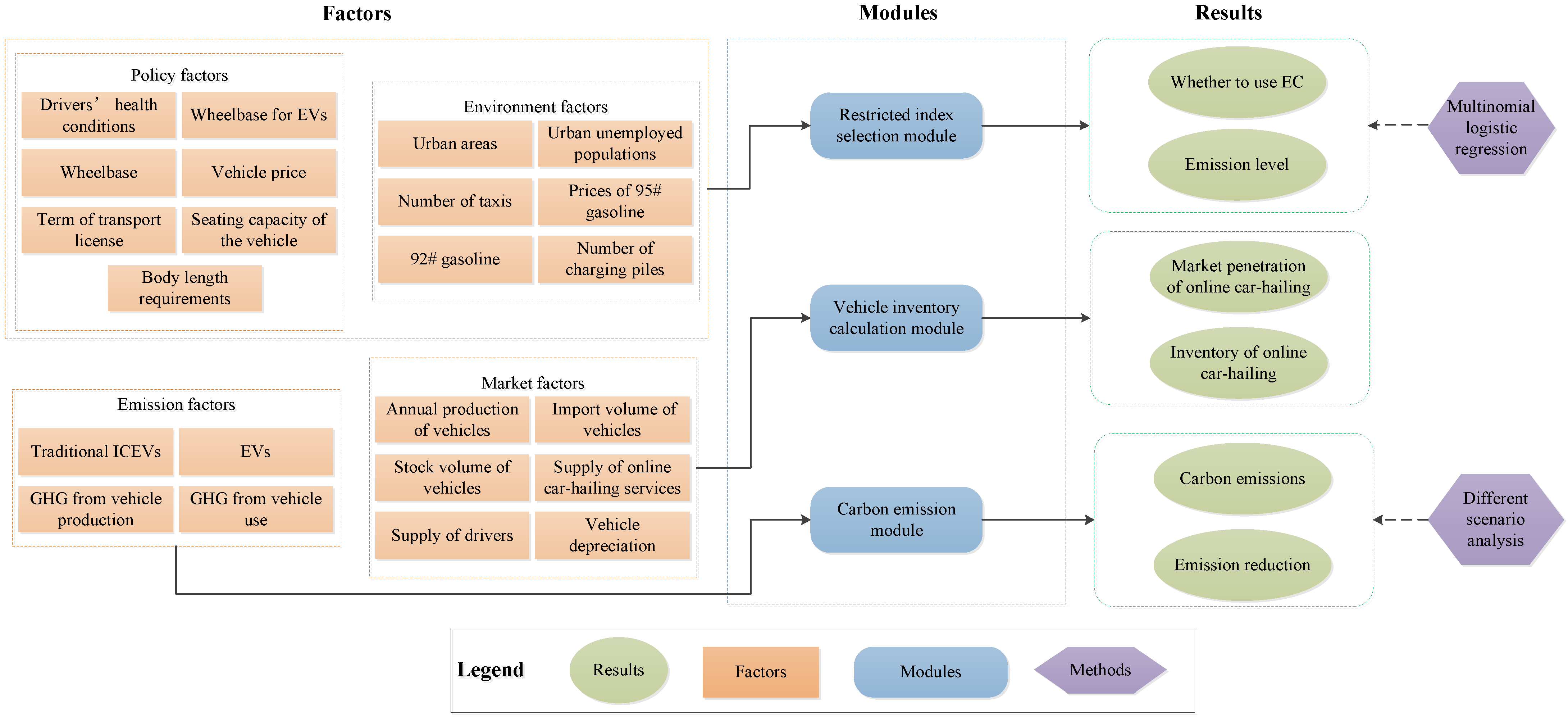
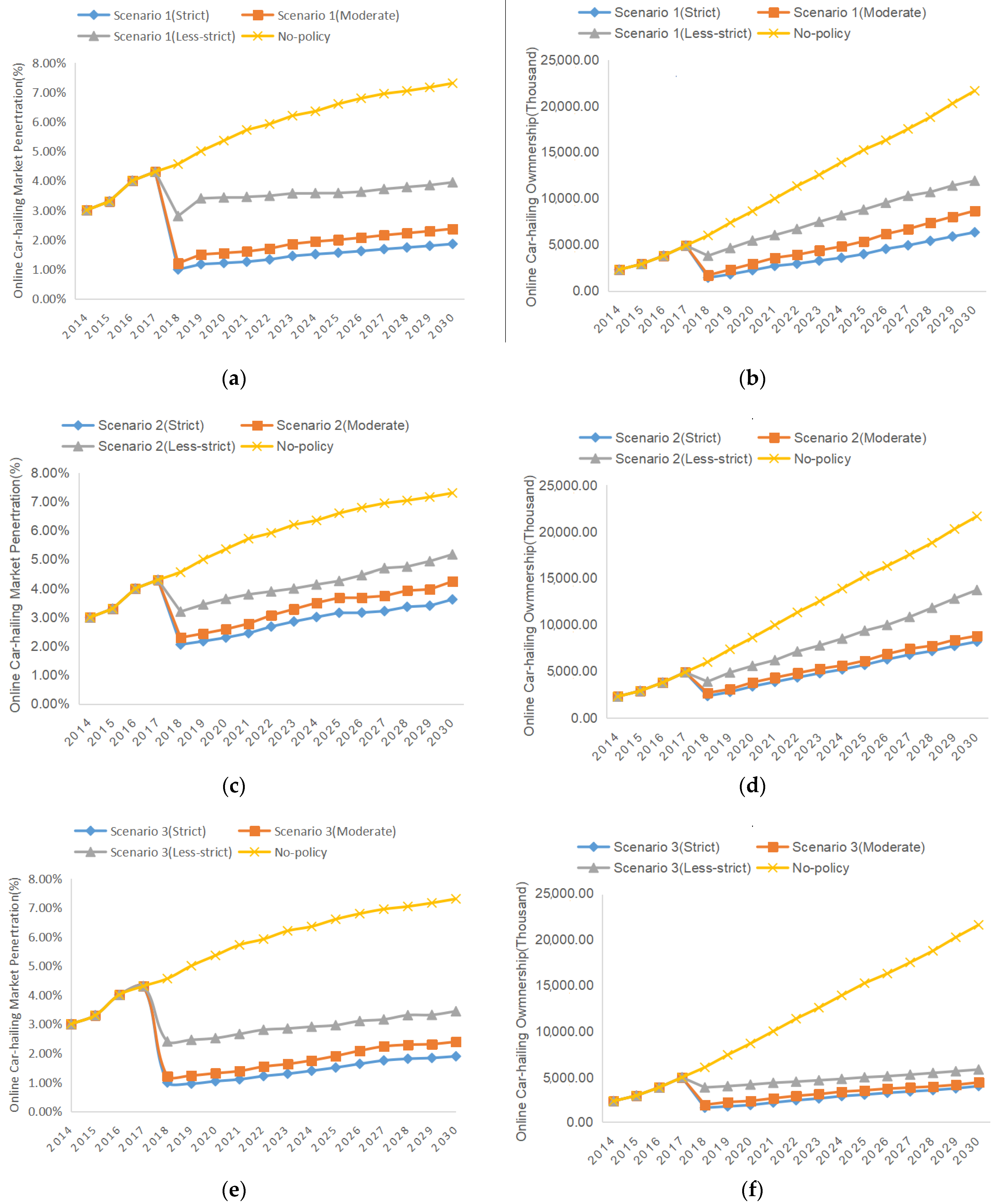
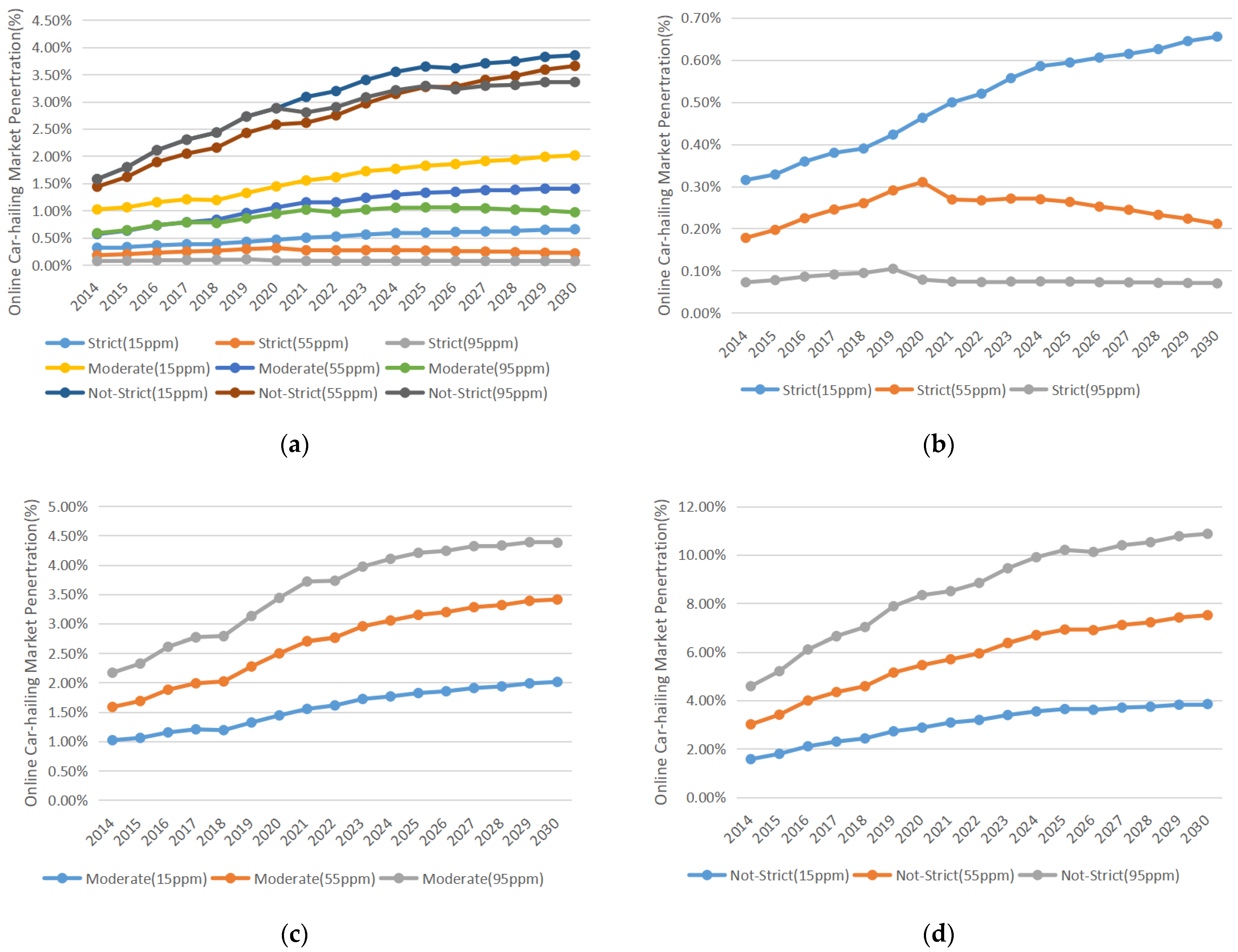
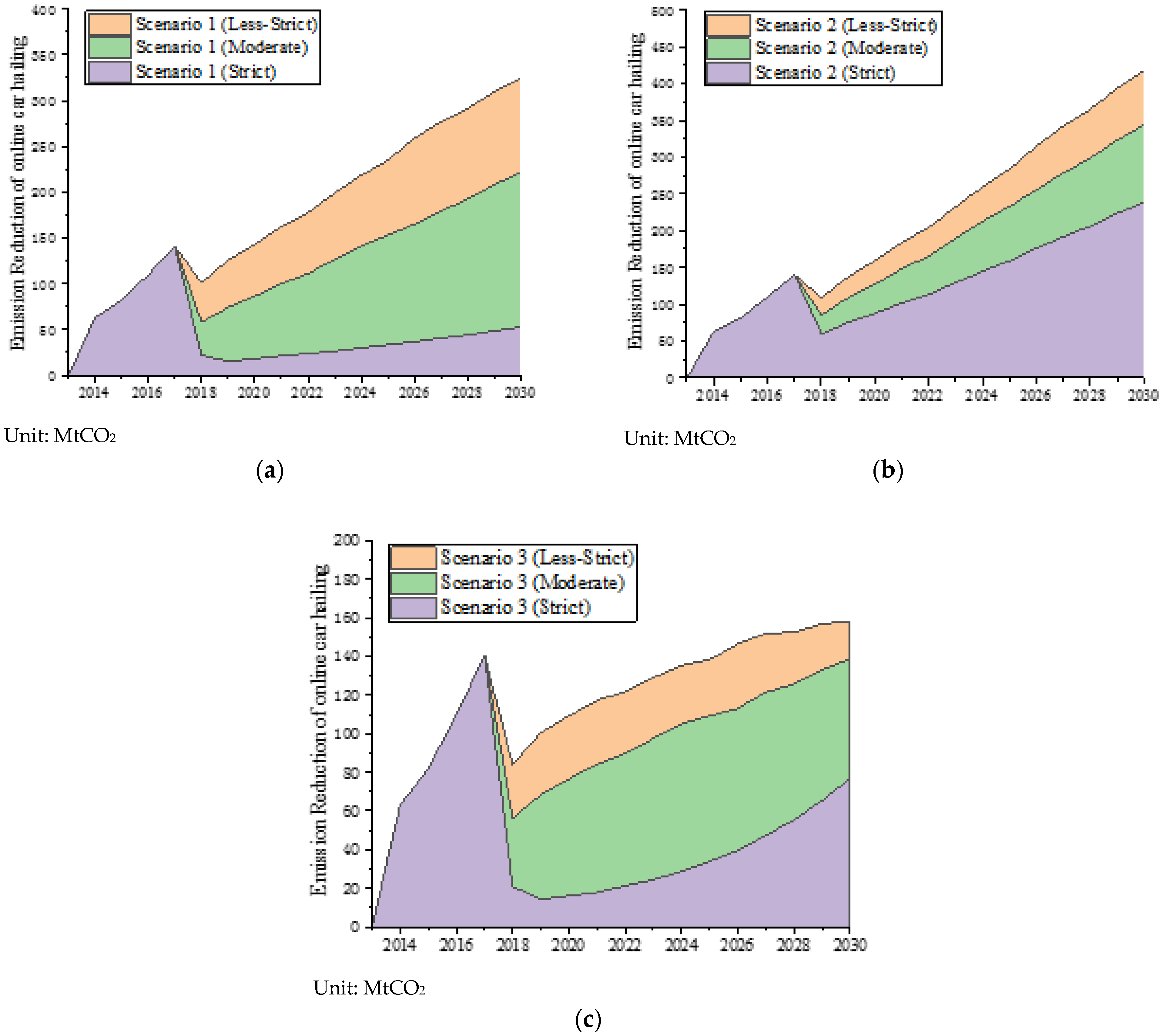
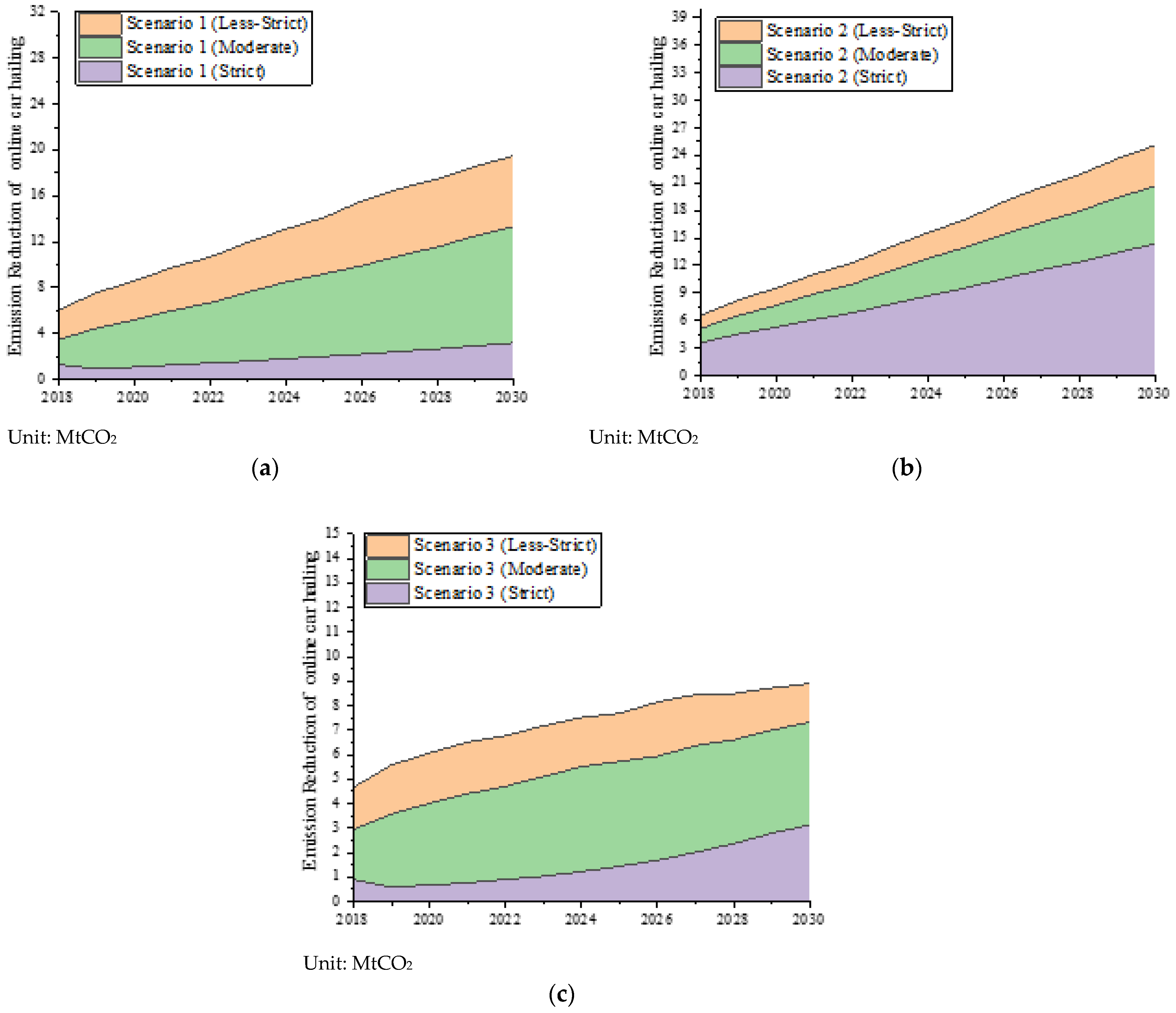
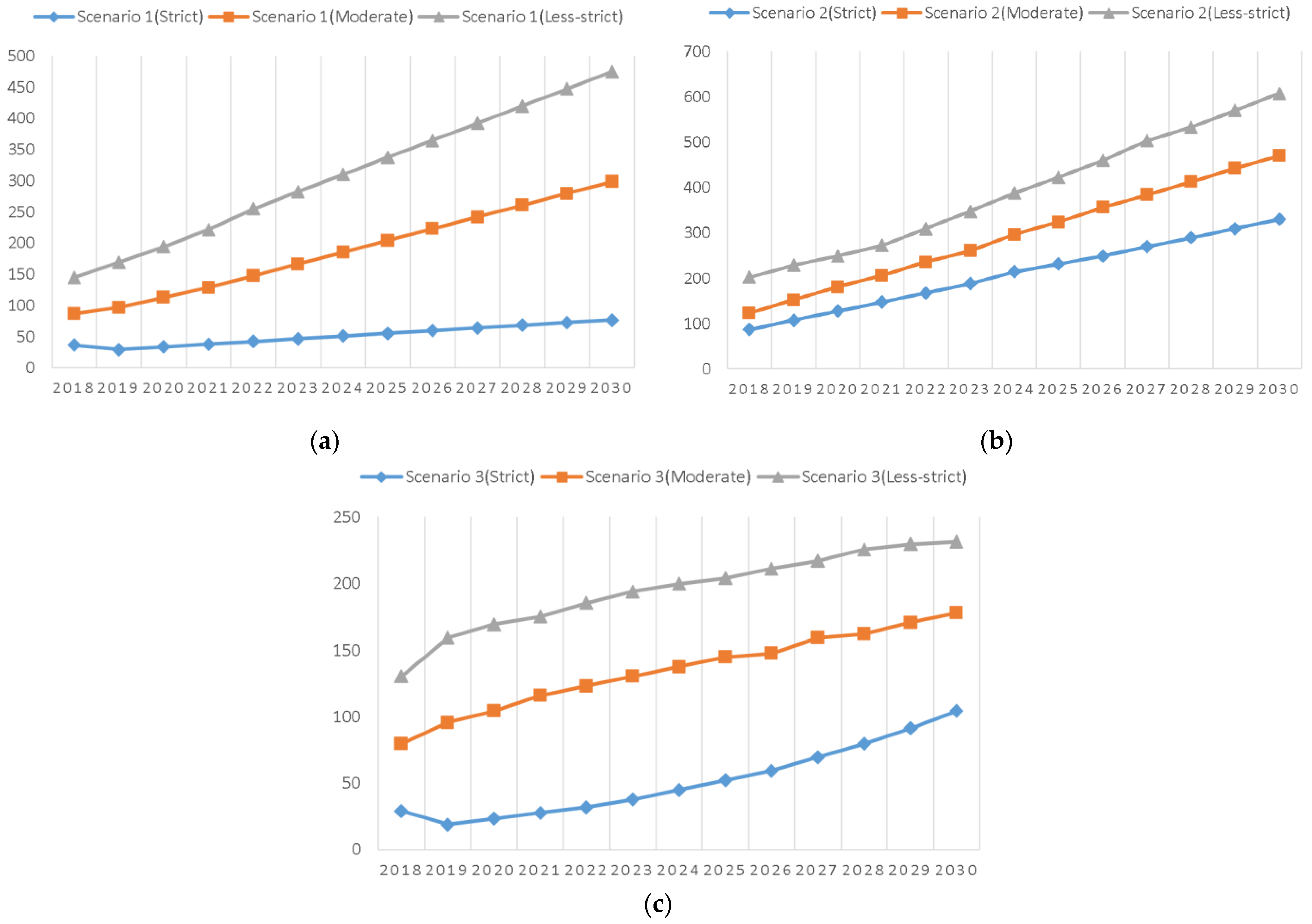
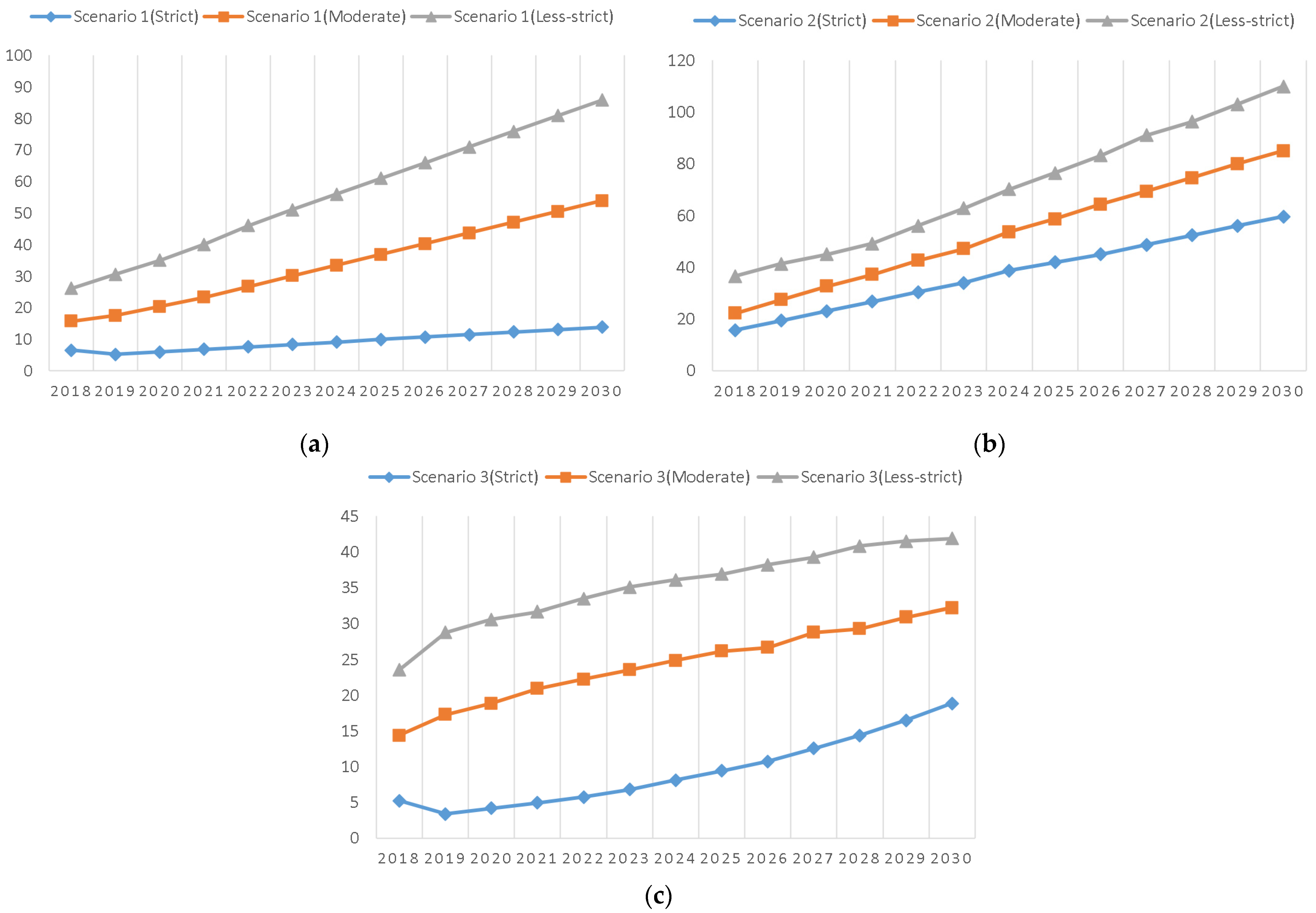
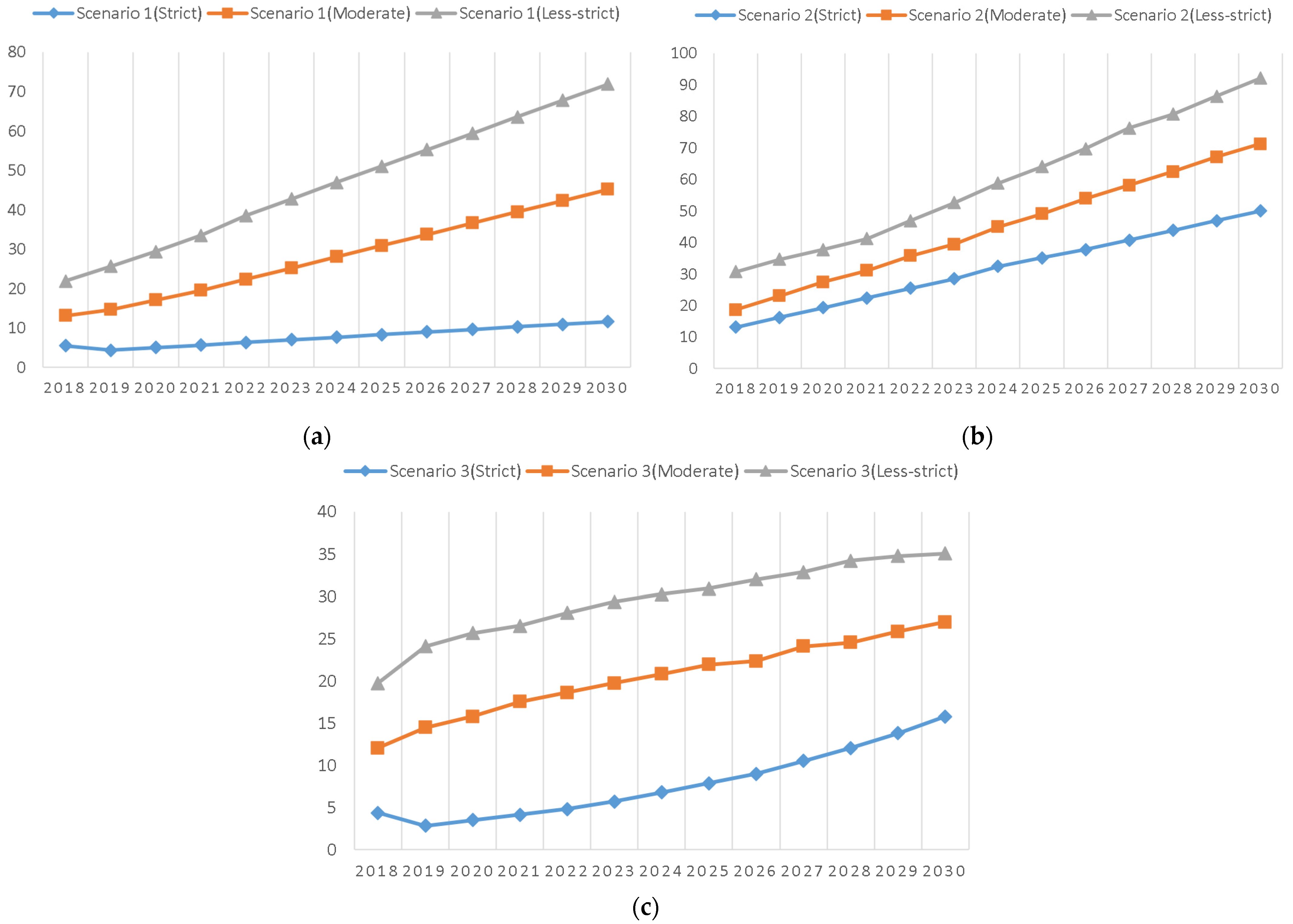
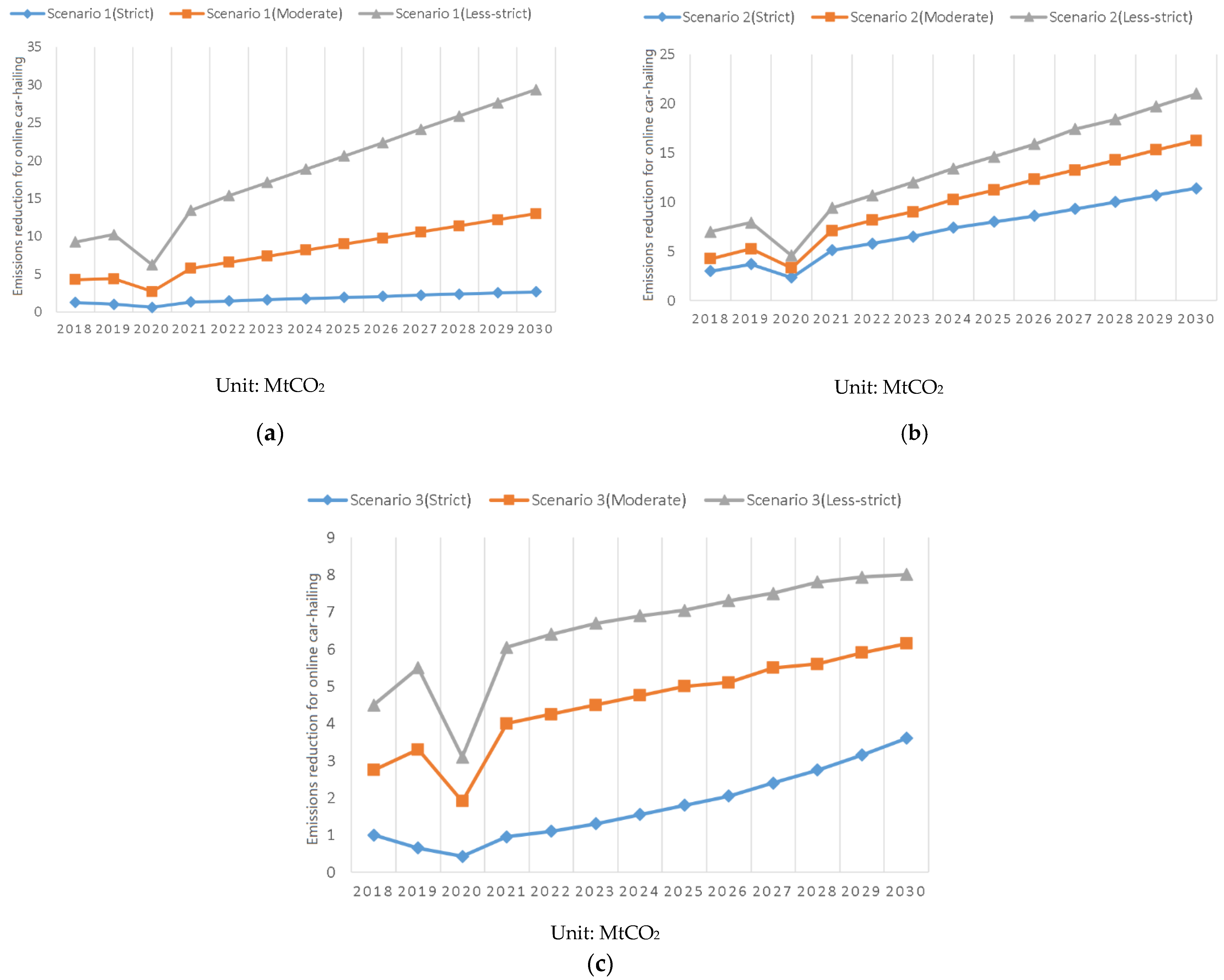
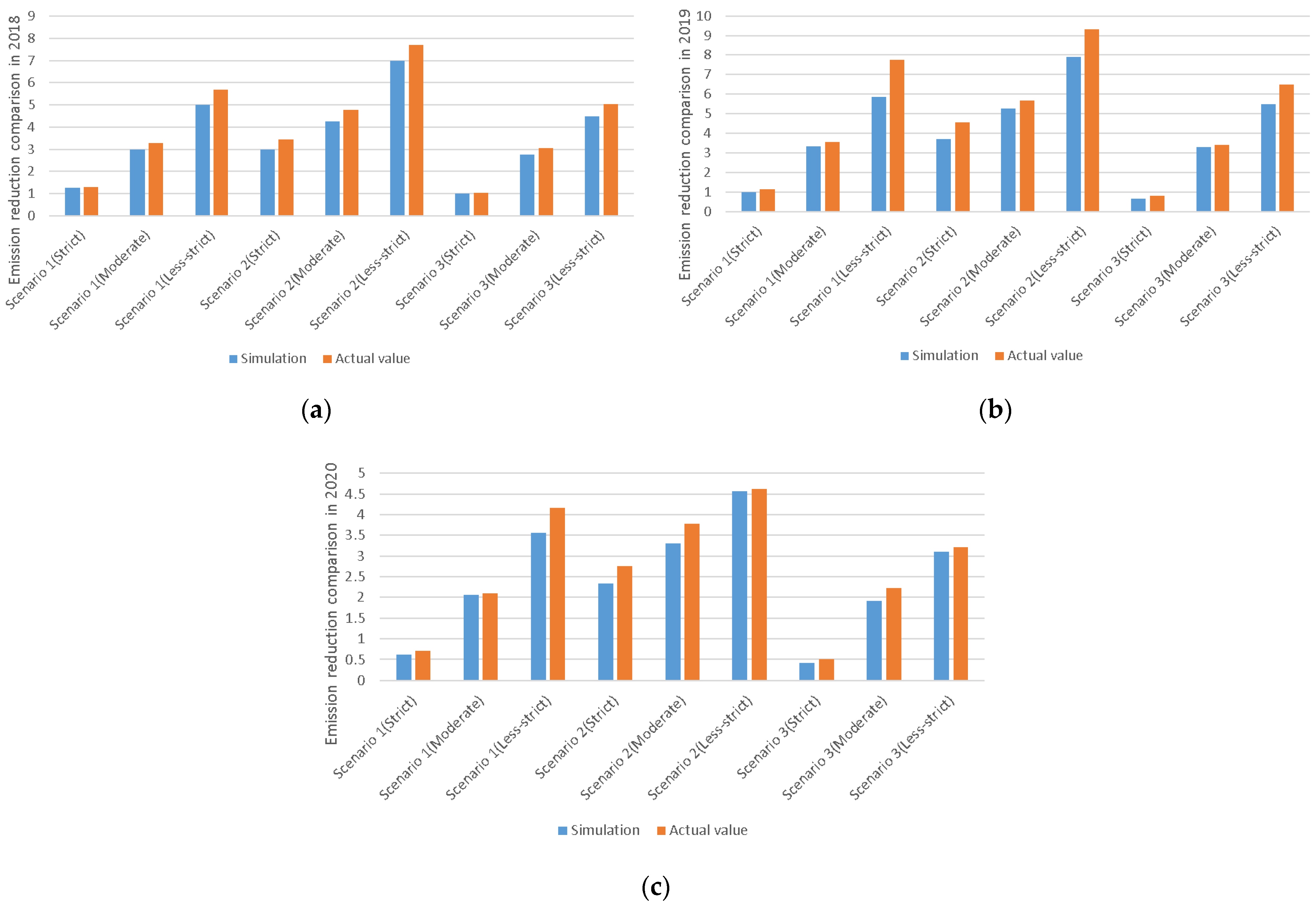
| Index | Attribute | Unit | 2016 | 2018 | 2020 | 2025 | 2030 |
|---|---|---|---|---|---|---|---|
| EVs wheelbase | Strict | Cm | 2600 | 2600 | 2610 | 2650 | 2700 |
| Moderate | 2500 | 2550 | 2550 | 2600 | 2600 | ||
| Less Strict | 2200 | 2400 | 2450 | 2450 | 2500 | ||
| Vehicle price (CNY) | Strict | Thousand | 100 | 100 | 140 | 140 | 140 |
| Moderate | 60 | 60 | 100 | 100 | 100 | ||
| Less Strict | 60 | 60 | 60 | 60 | 60 | ||
| Term of driving license | Strict | Year | 1 | 1 | 1 | 1 | 1 |
| Moderate | 3 | 3 | 3 | 3 | 3 | ||
| Less Strict | 6 | 6 | 6 | 6 | 6 | ||
| Transport license term | Strict | Year | 3 | 3 | 3 | 4 | 4 |
| Moderate | 5 | 5 | 5 | 6 | 6 | ||
| Less Strict | 7 | 7 | 8 | 8 | 8 | ||
| Seating capacity of the vehicle | Strict | NA\Yes | Yes | Yes | Yes | Yes | Yes |
| Moderate | Yes | Yes | Yes | Yes | Yes | ||
| Less Strict | NA | NA | NA | NA | NA | ||
| Health condition of the driver | Strict | NA\Yes | Yes | Yes | Yes | Yes | Yes |
| Moderate | NA | Yes | Yes | Yes | Yes | ||
| Less Strict | NA | NA | NA | NA | NA | ||
| Body length requirements | Strict | NA\Yes | Yes | Yes | Yes | Yes | Yes |
| Moderate | NA | NA | NA | NA | NA | ||
| EV wheelbase | Less Strict | NA | NA | NA | NA | NA |
| Main Driving Factors | Unit | 2016 | 2018 | 2020 | 2025 | 2030 |
|---|---|---|---|---|---|---|
| Urban unemployed population | Thousand (CNY) | 16.617 | 17.126 | 17.79 | 19.45 | 21.109 |
| Number of taxis | Thousand (CNY) | 3.495 | 3.634 | 3.76 | 4.075 | 4.39 |
| Price of 95# gasoline | RMB/L | 7.4 | 7.6 | 7.8 | 8.3 | 8.8 |
| Price of 92# gasoline | RMB/L | 6.9 | 7.1 | 7.3 | 7.8 | 8.3 |
| Charging piles | Thousand (CNY) | 0.068 | 0.086 | 0.189 | 0.538 | 0.888 |
| Major Estimates | Unit | 2016 | 2018 | 2020 | 2025 | 2030 |
|---|---|---|---|---|---|---|
| Market shares of online car-hailing | % | 4.0 | 5.0 | 5.8 | 7.3 | 8.0 |
| EV sales | Thousand | 408 | 887 | 2000 | 7201 | 15,000 |
| Base | Level 1 (1–1.6 L) | Level 2 (1.7–2 L) | Level 3 (2 L or More) | |||
|---|---|---|---|---|---|---|
| Displacement Type | Level 2 (1.7–2 L) | Level 3 (2 L or More) | Level 1 (1–1.6 L) | Level 3 (2 L or More) | Level 1 (1–1.6 L) | Level 2 (1.7–2 L) |
| Driving license term | −0.127 | 0.315 * | 0.127 | 0.442 ** | −0.315 * | −0.442 ** |
| (−1.01) | (−2.18) | (−1.01) | (−2.7) | (−2.18) | (−2.76) | |
| Vehicle prices | −1.400 *** | −0.238 | 1.400 *** | 1.162 *** | 0.238 | −1.162 *** |
| (−4.95) | (−0.81) | (−4.95) | (−3.31) | (−0.81) | (−3.31) | |
| Number of seats | 1.674 * | 2.129 ** | −1.674 * | 0.455 | −2.129 ** | −0.455 |
| (−2.43) | (−2.61) | (-2.43) | (−0.63) | (−2.61) | (−0.63) | |
| Health | 1.232 *** | 1.175 * | −1.232 *** | −0.0565 | −1.175 * | 0.0565 |
| (−3.31) | (−2.05) | (−3.31) | (−0.09) | (−2.05) | (−0.09) | |
| Bodywork length | 0.213 | 1.849 * | −0.213 | 1.635 * | −1.849 * | −1.635 * |
| (−0.35) | (−2.46) | (−0.35) | (−2.11) | (−2.46) | (−2.11) | |
| Transport license term | 0.0227 | −0.187 | −0.0227 | −0.209 | 0.187 | 0.209 |
| (−0.29) | (−1.41) | (−0.29) | (−1.54) | (−1.41) | (−1.54) | |
| BC wheelbase | 0.188 ** | 0.247 ** | −0.188 ** | 0.0592 | −0.247 ** | −0.0592 |
| (−3.25) | (−2.77) | (−3.25) | (−0.64) | (−2.77) | (−0.64) | |
| Fuel 95 | 10.14 *** | 2.343 | −10.14 *** | −7.801 | −2.343 | 7.801 |
| (−3.34) | (−0.53) | (−3.34) | (−1.67) | (−0.53) | −1.67 | |
| Fuel 92 | −8.446 * | −3.271 | 8.446 * | 5.175 | 3.271 | −5.175 |
| (−2.47) | (−0.63) | (−2.47) | (−0.95) | (−0.63) | (−0.95) | |
| Unemployed people × 10−4 | 0.564 ** | −0.0312 | −0.564 ** | −0.595 ** | 0.0312 | 0.595 ** |
| (−2.86) | (−0.18) | (−2.86) | (−2.63) | (−0.18) | (−2.63) | |
| Number of taxis | −0.000230 * | 0.000122 | 0.000230 * | 0.000352 * | −0.000122 | −0.000352 * |
| (−2.01) | (−1.04) | (−2.01) | (−2.47) | (−1.04) | (−2.47) | |
| Charging pile | −0.00335 | −0.000476 | 0.00335 | 0.00287 | 0.000476 | −0.00287 |
| (−1.38) | (−0.16) | (−1.38) | (−0.88) | (−0.16) | (−0.88) | |
| Constant | −17.11 | −1.696 | 17.11 | 15.41 | 1.696 | −15.41 |
| (−1.72) | (−0.10) | (−1.72) | (−0.83) | (−0.1) | (−0.83) | |
| N | 234 | 234 | 234 | 234 | 234 | 234 |
Publisher’s Note: MDPI stays neutral with regard to jurisdictional claims in published maps and institutional affiliations. |
© 2022 by the authors. Licensee MDPI, Basel, Switzerland. This article is an open access article distributed under the terms and conditions of the Creative Commons Attribution (CC BY) license (https://creativecommons.org/licenses/by/4.0/).
Share and Cite
Zeng, I.Y.; Chen, J.; Niu, Z.; Liu, Q.; Wu, T. The GHG Emissions Assessment of Online Car-Hailing Development under the Intervention of Evaluation Policies in China. Sustainability 2022, 14, 1908. https://doi.org/10.3390/su14031908
Zeng IY, Chen J, Niu Z, Liu Q, Wu T. The GHG Emissions Assessment of Online Car-Hailing Development under the Intervention of Evaluation Policies in China. Sustainability. 2022; 14(3):1908. https://doi.org/10.3390/su14031908
Chicago/Turabian StyleZeng, Isabella Yunfei, Jingrui Chen, Ziheng Niu, Qingfei Liu, and Tian Wu. 2022. "The GHG Emissions Assessment of Online Car-Hailing Development under the Intervention of Evaluation Policies in China" Sustainability 14, no. 3: 1908. https://doi.org/10.3390/su14031908
APA StyleZeng, I. Y., Chen, J., Niu, Z., Liu, Q., & Wu, T. (2022). The GHG Emissions Assessment of Online Car-Hailing Development under the Intervention of Evaluation Policies in China. Sustainability, 14(3), 1908. https://doi.org/10.3390/su14031908







